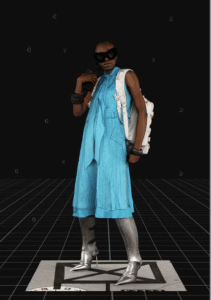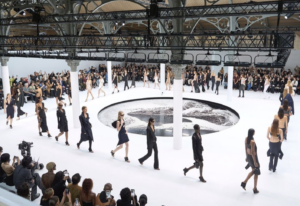How brands are reinventing fashion shows to meet new consumer expectations and technological innovations
Fashion Weeks have always held a central place in the fashion industry. These events, once reserved for industry professionals, were the pinnacle where designers presented their collections to buyers, celebrities, and the media. Every year, fashion shows held in cities like Paris, Milan, New York, and London reveal the trends that will define the upcoming seasons. However, with the rise of digitalization and changing public expectations, the format of these events has significantly evolved. Today, brands must reinvent the fashion show experience to adapt to an ever-changing world. Fashion shows scenography and technology, including digitalization, immersive experiences, and increased accessibility, are redefining these iconic events.
Traditional fashion weeks as an irreplaceable physical experience
Physical fashion shows offer a unique sensory experience, where every detail is carefully orchestrated to captivate the audience’s attention. Over the years, these events have become more akin to Hollywood productions than simple clothing presentations. Set design has become a crucial strategic element, allowing brands to tell a story and amplify the impact of their collections.
Fashion set scenography, art at the service of brands
More than just a backdrop, the fashion show’s set design is a true extension of a brand’s universe. It immerses the audience in a world where every visual, sound, and even olfactory element is designed to evoke emotion and reinforce the collection’s message. Lighting, soundscapes, and even scents are thoughtfully planned to create an unforgettable experience.
.For his Fall-Winter 2022-2023 show, Rick Owens introduced small portable machines, carried by the models, to diffuse a unique fragrance created in collaboration with the skincare brand Aesop.
Certain brands excel particularly in the scenography of their fashion shows. 
Behind these impressive spectacles are renowned set designers like Alexandre de Betak (Bureau Betak), Dévi Sok, and Olivier Massart, who work with top houses like Gucci, Louis Vuitton, Dior, and Saint Laurent. Their mission? To create immersive settings that respect the brand’s DNA, enhancing the collections and leaving a lasting impression. The fashion show becomes a living painting where every element contributes to a powerful visual narrative.
The physical audience plays a key role in the success of a fashion show. Influencers, celebrities, buyers, and journalists all contribute to amplifying the media resonance of the collections. In a world where events are digitized and live-streamed, the stakes are even higher: every show is scrutinized, analyzed, and immediately shared on social media.
Furthermore, the exclusivity of invitations to Fashion Weeks enhances the prestige of the brands. Being invited to a show is a privilege that solidifies the relationship between the brand and its ambassadors. This selective aspect fuels desire and maintains an elitist image, which is central to luxury.
Fashion Weeks are not only showcases of creativity but also powerful platforms for storytelling and marketing.
Will the rise of digital lead to a borderless Fashion Week?
The acceleration of digital formats with the pandemic
The rise of digital has transformed Fashion Week into a global event, now accessible to all. The pandemic accelerated this shift, prompting brands to adopt new formats like live streaming, allowing viewers from around the world to watch the shows in real-time. Some brands have even innovated with immersive digital experiences, such as Balenciaga presenting a collection as a video game, or Gucci exploring the metaverse with interactive experiences. Coperni also made waves with viral stunts, like the live spraying of Bella Hadid’s dress.
Digitalization has enabled brands to expand their presence on social media and democratize fashion shows. Platforms like Instagram, YouTube, and TikTok have opened these events to a wider audience, pushing the boundaries of what were once elite-only fashion shows. TikTok, in partnership with the Fédération de la Haute Couture, now allows audiences to follow shows in real-time. The role of influencers has become key for brands, boosting their visibility through popular hashtags, exclusive behind-the-scenes content, and live images from the shows.
Digital alternatives: Virtual fashion shows
Digital fashion shows gained significant momentum during the pandemic, such as Balmain’s show on TikTok or Dior’s short film presentation, offering alternatives to traditional physical runway displays. A variety of formats emerged, from live shows on Instagram to edited films like those of Jacquemus, and even virtual reality experiences, like Balenciaga’s for its Fall/Winter 2021 collection. The future of Fashion Weeks seems to be heading towards a “phygital” approach, combining both physical and digital experiences, with brands creating hybrid formats for total immersion.
Challenges and opportunities in the metaverse and digital fashion
The shift towards digital fashion raises new challenges. The metaverse, with events like Metaverse Fashion Week, introduces several issues, such as protecting intellectual property, the environmental impact of metaverse and blockchain energy consumption, making digital fashion accessible to all, preserving the authenticity and exclusivity of virtual pieces, and establishing fair monetization models for creators and brands. These challenges are pushing the fashion industry to rethink its strategies and adapt to a new digital universe while balancing innovation with responsibility. Brands like Balenciaga and Gucci have launched exclusively digital collections, offering creative freedom without physical constraints. Dolce & Gabbana has integrated NFTs into their collections, allowing the purchase of exclusive virtual pieces. Louis Vuitton offers interactive experiences with virtual showrooms and augmented reality apps.
The physical experience stays irreplaceable and multisensory
Although digitalization has made Fashion Weeks more accessible, it cannot replace the physical experience. As neuroscientist Charlotte Rolland explains, a live fashion show is a multisensory experience: textures, sounds, and smells are perceived—elements that are absent online. Emotion, central to the experience, is also harder to evoke virtually, where viewers’ attention may easily wander. However, Rolland highlights that digitalization can complement the physical experience if it focuses on storytelling and emotion. Despite the creative possibilities of the metaverse and virtual events, physical fashion shows remain irreplaceable for their sensory and emotional dimensions.
A fashion week in constant reinvention
Fashion Weeks, while remaining flagship events in the fashion industry, are evolving rapidly to meet the expectations of modern consumers and technological innovations. While digitalization has democratized the runway shows, making the event accessible to a global audience through formats like live streaming, the metaverse, and immersive experiences, the physical experience remains indispensable. By offering a unique sensory immersion, live fashion shows continue to convey deep emotions and create more authentic connections with the audience. However, the possibilities offered by new technologies, including virtual fashion shows and phygital formats, expand creative horizons and cater to increasingly diverse needs.
In this context, fashion seems to be heading towards a hybrid path, where physical and digital experiences complement each other to offer total immersion. While virtual fashion raises ethical and environmental questions, it also paves the way for a new creative era. Couture houses now face the challenge of integrating these new dimensions while preserving their DNA and craftsmanship. The reinvention of Fashion Weeks is not just a passing trend but a response to the transformations of an increasingly globalized and technological world, where balancing tradition and innovation is becoming essential.








Leave a comment: